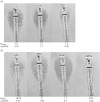Contribution of OmpK36 to carbapenem susceptibility in KPC-producing Klebsiella pneumoniae
- PMID: 19556371
- PMCID: PMC2887543
- DOI: 10.1099/jmm.0.012575-0
Contribution of OmpK36 to carbapenem susceptibility in KPC-producing Klebsiella pneumoniae
Abstract
Isolates of Klebsiella pneumoniae harbouring the carbapenemase KPC may have carbapenem MICs that remain in the susceptible range, and may therefore go unrecognized. To understand the mechanisms contributing to the variability in carbapenem MICs, 20 clinical isolates, all belonging to either of two clonal groups of KPC-possessing K. pneumoniae endemic to New York City, were examined. Expression of genes encoding KPC, the porins OmpK35 and OmpK36, and the efflux pump AcrAB was examined by real-time RT-PCR. Outer-membrane profiles of selected KPC-producing isolates were examined by SDS-PAGE, and proteins were identified by matrix-assisted laser desorption/ionization mass spectrometry. The identification of SHV and TEM beta-lactamases and the genomic sequences of ompK35 and ompK36 were determined by PCR and DNA sequencing, respectively. For one clonal group, carbapenem MICs increased with decreasing expression of ompK36. A second clonal group also had carbapenem MICs that correlated with ompK36 expression. However, all of the isolates in this latter group continued to produce OmpK36, suggesting that porin configuration may affect entry of carbapenems. For isolates that had the greatest expression of ompK36, carbapenem MICs tended to be lower when determined by the broth microdilution technique, and scattered colonies were seen around the Etest zones of inhibition. All of the KPC-producing isolates were highly resistant to ertapenem, regardless of ompK36 expression. In conclusion, isolates of KPC-possessing K. pneumoniae that express ompK36 tend to have lower MICs to carbapenems and therefore may be more difficult to detect by clinical laboratories. Regardless of ompK36 expression, all of the KPC producers were consistently resistant to ertapenem.
Figures


References
-
- Ardanuy, C., Liñares, J., Domínguez, M. A., Hernández-Allés, S., Benedí, V. J. & Martínez-Martínez, L. (1998). Outer membrane profiles of clonally related Klebsiella pneumoniae isolates from clinical samples and activities of cephalosporins and carbapenems. Antimicrob Agents Chemother 42, 1636–1640. - PMC - PubMed
-
- Bradford, P. A., Urban, C., Mariano, N., Projan, S. J., Rahal, J. J. & Bush, K. (1997). Imipenem resistance in Klebsiella pneumoniae is associated with the combination of ACT-1, a plasmid-mediated AmpC β-lactamase, and the loss of an outer membrane protein. Antimicrob Agents Chemother 41, 563–569. - PMC - PubMed
-
- Bratu, S., Landman, D., Haag, R., Recco, R., Eramo, A., Alam, M. & Quale, J. (2005a). Rapid spread of carbapenem-resistant Klebsiella pneumoniae in New York City. Arch Intern Med 165, 1430–1435. - PubMed
Publication types
MeSH terms
Substances
Associated data
- Actions
- Actions
- Actions
Grants and funding
LinkOut - more resources
Full Text Sources
Molecular Biology Databases

